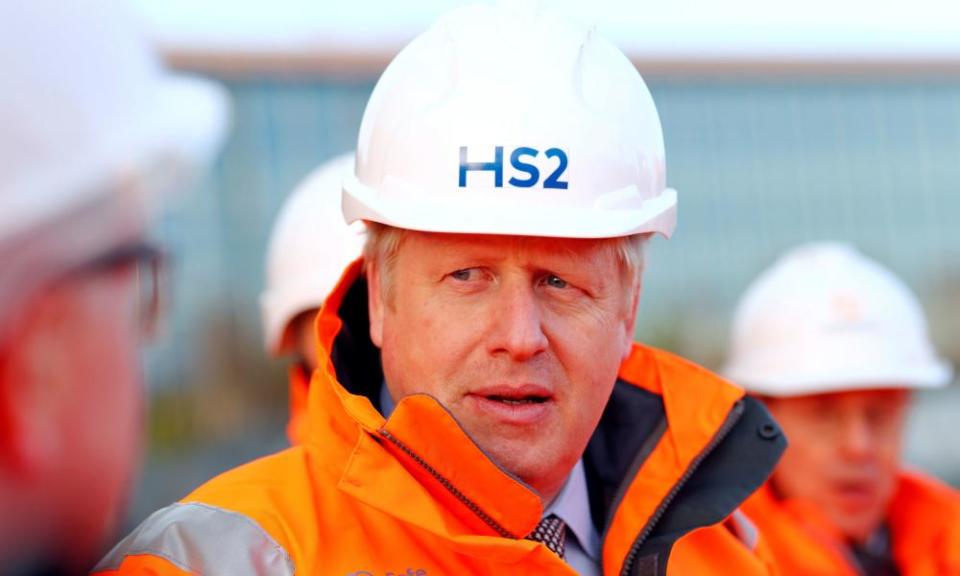Depleted and unwanted, HS2 hurtles on as Johnson’s £100bn vanity project

Britain’s new high-speed railway will not – repeat: not – get to the north of England. It will go back and forth from London to the Midlands and its chief beneficiaries will be London commuters. All else is political spin.
This became certain last week as the government’s internal major projects authority declared phase two of the HS2 project, to Manchester and Leeds, effectively dead. While the already-started London-to-Birmingham stretch is still marked at “amber/red” for “successful delivery in doubt”, anything north of Crewe has been designated “unachievable”. Its multitudinous issues “do not appear to be manageable or resolvable”. This comes not from the arms-length National Infrastructure Commission or last winter’s Oakervee report, both agreeing that going beyond Birmingham should be “reviewed”. This was the verdict of an arm of the Treasury and Cabinet Office.
Since HS2 has always been politics-driven – no rail strategy ever gave it priority – it has raced past every red light for a decade. By far Europe’s biggest infrastructure scheme, it has finally been overtaken by its own extravagance. The pandemic has sent commuter numbers plummeting and wrecked any remotely plausible rate of return.
The only way of conveying the scale of Johnson’s vanity in this vanity project is to convey its opportunity cost, a projected £106bn (and rising) over 20 years. That is the price of hundreds of new NHS hospitals or thousands of new secondary schools. It is seven times the cost of the education Covid recovery project proposed last spring but rejected by Johnson as too costly. It is the same additional annual cost to 2040 as the projected new social care scheme – still considered too expensive. HS2 is in that spending league. These are real choices.
This one train line will consume the equivalent of Britain’s entire projected railway investment budget during its two decades of construction. Even the initial phase to Birmingham, at roughly £70bn, is twice the £40bn cost of the “northern powerhouse” rail system, which every infrastructure pundit agrees should be built first. Yet that system is now in serious danger of being delayed or never completed. HS2 is a glaring “levelling-down” of the north.
The railway’s route was projected as a nostalgic echo of Robert Stephenson’s first line from Euston to Birmingham, travelling between Birmingham’s as yet non-existent Curzon Street station and a Euston station that does not link with HS1 and the Channel tunnel (and is not even on the new Crossrail). No one boarding a train in the north will be able to travel directly to France. As for Curzon Street in Birmingham, it is a mile from the New Street interchange and the west coast main line. This makes absolutely no sense.
Even Lord Adonis, for whom HS2 was the holy grail, accepts it should probably now stop at Acton’s Old Oak Common hub. Meanwhile arguments, some of them court cases, continue over the trains themselves. They are not planned to tilt, which means that any time saved on a new track to Birmingham will be lost on winding track further north. A re-signalled King’s Cross line could even get to Scotland faster. HS2 is more a taxpayer-funded theme park than a railway.
The project has long been out of control. It is a spending black hole: figures in 2018 showed its latest boss Mark Thurston having to be paid over £660,000 a year, with 15 of his colleagues on over £250,000. A quarter of all HS2 staff, over 300 people, received above £100,000. The Commons public accounts committee declared it to be “badly off course” and lacking even the most “basic financial controls.” This is despite the outlay of £600m annually on consultants, including £35m on the “big four” accountancy firms.
It is never too late to stop a dud project, but it requires ever more courage to do so. Not a mile of track has been laid – the only tunnels have been built by Swampy. What is intriguing is how HS2 has mutated from from a transport project to political machismo – “infrastructure” that is good in itself. Like Johnson’s garden bridges and crony PPE contracts, the more extravagant they are, the more they can be described as “world-beating”.
A recent Institute for Government seminar on HS2 received a devastating report on this whole saga from Professor Stephen Glaister of Imperial College. A Whitehall official present was heard to reflect that, in the light of Covid constraints, the railway could forget any other serious investment. Greater Manchester’s mayor, Andy Burnham, was an uncritical backer of HS2 when he thought it would get him fast to London. He will now find Birmingham blessed with cash that might have renovated his dire northern powerhouse rail network three times over – money he may now never see.
Rishi Sunak claims to want to start saving, not spending. Yet as long as HS2 sits in his budget he is hamstrung. He cannot tell doctors, nurses or teachers that he “cannot afford” their desperate requests. If he can afford HS2, he can afford anything. The truth is that this staggering vanity project survives for one reason. It looks good from London.
Simon Jenkins is a Guardian columnist

 Yahoo News
Yahoo News 